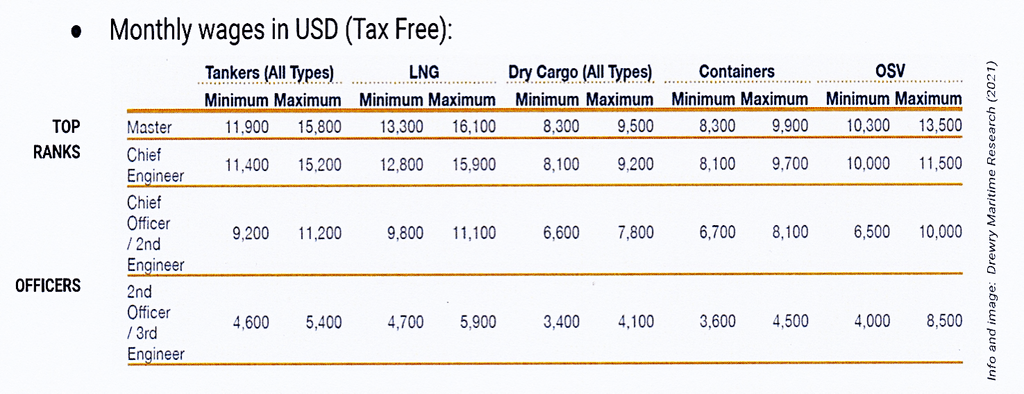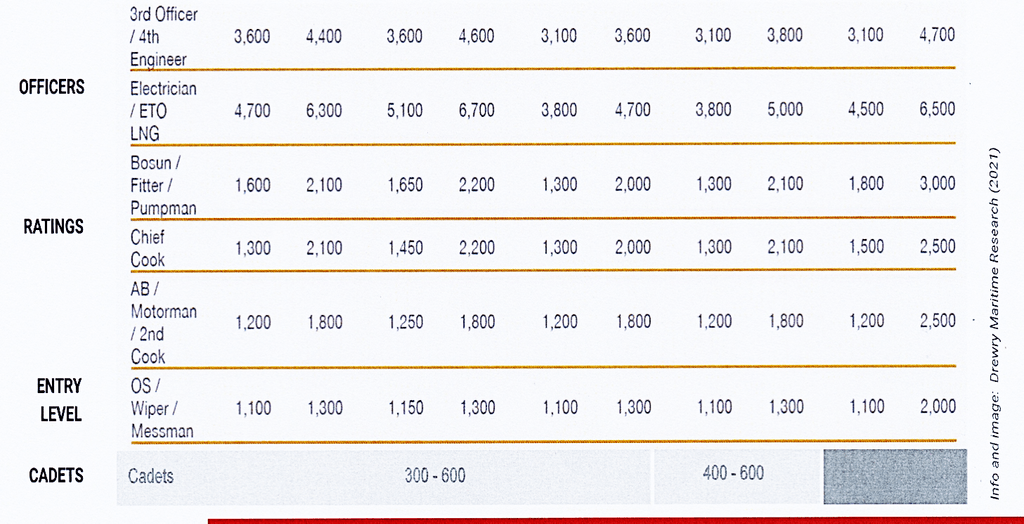SUMMARY
This is AI generated summarization, which may have errors. For context, always refer to the full article.
![[Vantage Point] Seafaring industry suffers steep freefall](https://www.rappler.com/tachyon/2023/03/Seafaring-industry-suffers-steep-freefall.jpg)
A ship oiler was only two days onboard when he allegedly experienced blurring vision in his right eye. After being returned to Manila, the doctors determined that the ailment was not work-related. The seafarer then filed a case with the National Conciliation and Mediation Board (NCMB) and was awarded $68,456 (P3.5 million) for permanent total disability, 120 days sickness allowance of $2,456, as well as 10% of his total monetary award to cover attorney’s fees.
The shipowner appealed this decision to the Court of Appeals which reversed it, and affirmed later by the Supreme Court (SC). The SC ordered that all awards paid out to the oiler be returned to the shipowner. Unfortunately for the seafarer, he is unable to return any portion of what had already been paid out.
In March 2014, a ship captain went home after his contract had been fulfilled. Six months later, he died in the Philippines due to throat carcinoma, an affliction that was not work-related. The captain’s wife immediately filed a complaint for $143,000 worth of death benefits at the Cebu office of the National Labor Relations Commission (NLRC-Cebu). The shipowner refused to pay because the captain was no longer under contract and had never requested any medical attention from either the crew manning agency or the shipowner. Nevertheless, NLRC-Cebu’s Decision affirmed the claims. The manning agency was mandated to produce a surety bond equivalent cash of P6.5 million as final payment.
An able seaman had been working onboard for nine months without any reported illness or injury. After disembarkation, however, he requested a new employment contract from the manning agency and underwent a pre-employment medical examination which declared him fit to work at sea. He then took a vacation before his redeployment, but tragically died three months later due to leptospirosis. His heirs filed a complaint against the shipowner and manning agency, seeking death benefits and other damages and attorney’s fees.
In this case, the Labor Arbiter’s decision was to award the seaman’s family the amount of $50,000 (P2.75 million) as death benefit, $21,000 (P1.115 million) as heir benefit, P50,000.00 for burial expenses, P100,000 for moral damages, P100,000 for exemplary damages, and attorney’s fees equivalent to 10% of the total monetary award. This ruling was affirmed by the NLRC.
Upon the appeal of the shipowner and manning agency to the CA and then to the SC, it was determined that there was insufficient evidence to prove any causal connection between the nature of seaman’s work at sea and his untimely death. The courts noted that he had reapplied for redeployment and passed all the necessary health examinations which declared him “fit for sea duty.”
These are just a few of the hundreds of “horror stories” told to me by maritime stakeholders who claimed to have received unjust and unfair decisions from the NLRC and NCMB.
“Even when we win on appeal, we are unable to recover any of the money we were mandated to pay seafarers,” said C.F. Sharp Crew Management president and chief executive officer Miguel Rocha.
Records obtained by Rappler reveal that from 2018 to 2022, 23% of rulings appealed by shipowners were ultimately reversed by the CA, representing an estimated value of P2.5 billion, which had never been returned to the shipowners. Between 2018 and 2022, the NCMB awarded some P2.576 billion to seafarers, but Rocha said more than this amount had been awarded “under duress,” since the “chance of winning at NCMB is less than 1%.” He said that “most of the claims could not be backed up by evidence.”
But why does the ruling of the NLRC and NCMB not jibe with the CA’s and SC’s decisions? Do seafarers and their families get the full amount of what was awarded to them? We can only speculate.
According to a seafarer’s widow whom Rappler was able to trace, the family only received a fraction, or P100,000, of the almost P2 million that was awarded to them.
Killing the goose that lay the golden eggs
The $6.5 billion seafaring industry has been on a freefall. From achieving the milestone of a 45% market share for merchant ships in 1995 – up from 34% in 1990 – the Philippines registered a measly 14% share of the global seafaring market between 2015 and 2021.
That 14% was aided only by the pandemic and the Ukraine war which caused a dearth of seafarers globally. Unfortunately, the industry cannot rely on pandemics and wars to keep on thriving.
It doesn’t take rocket science to conclude that the ludicrous act of both the NLRC and NCMB could have caused the decline. According to an audit done by the European Maritime Safety Agency (EMSA), there is now a risk of “derecognition of Filipino seafarer officers by European countries.” This means that the time may come when Filipino seafarers can no longer sail on European-flagged vessels.
According to Iris Baguilat, president of Döhle Seafront Crewing (Manila), Incorporated, the other causes of the much-reduced share of the Philippines in the global market are: suspension and cancellations of manning licenses that disrupt ship operations; inflexible wage structures – 20% reduction cap which makes Filipino seafaring sector non-competitive; the way crew manning agencies are treated as catch-all employment agreement; weak regulations on unlicensed and illegal recruitment activities, especially online; and our government’s limited understanding of and recognition for the strong global industry regulations, the safety culture, and highly rewarding career and benefits of seafarers in international shipping.
But the biggest threat of all, Baguilat says, is the exploitation of the seafarer compensation system and ambulance chasing. All these, according to the International Maritime Employers’ Council (IMEC), could lead to the extinction of the country’s seafaring industry in 10 years.
The table below shows how lucrative a seafarer’s career is.


At present, thousands of Filipino seafarers are jobless.
Records from the Philippine Overseas Employment Administration (POEA) reveal that some 387,072 sea-based workers were deployed in 2016, down from 2015’s 442,820. Today, there are only 174,000 seafarers deployed at any given time on international vessels. These are not just cold statistics written on Excel spreadsheets. This is flesh-and-bone reality where the sustenance of thousands of Filipino families are at stake.
Ambulance chasing
The dictionary defines ambulance chasing as the attempt by a lawyer or a paralegal subordinate to actively go after an accident or disaster victim or any individual involved in a potentially big legal issue with the intent to file cases on their behalf to get the biggest settlement possible.
Ambulance chasing is against the Code of Professional Responsibility that lawyers swore to. Lawyers are said to be “ambulance chasing when they persuade their clients to file charges against their employers instead of negotiating with them.” Under the law, ambulance chasing specifically involving seafarers is prohibited under Republic Act No. 10706 or the Seafarers Protection Act.
Rocha said that ambulance chasers lure seafarers into this nefarious activity, where an appellant seeks compensation based on fictitious or frivolous claims of injury. He said the practice has disappointed and disheartened foreign shipowners from further hiring Filipino seafarers. This despicable practice has added to the country’s worsening economic situation, and bloated the number of unemployed maritime graduates each year.
He said compensation claims are determined by NLRC or NCMB arbitrators or arbiters under the Department of Labor and Employment. Claims decided in favor of the complainant are immediately settled after judgment. Refusal to pay, Rocha noted, may result in the garnishment of the shipowners’ and/or the manning agencies’ financial accounts. Little or no recourse is left for recovering the amount paid to the complaining party even in cases where the arbitrator’s judgment is overturned by the CA or the SC.
Labor lawyers of the lowest kind have found the system highly lucrative. In cahoots with crooked arbitrators, ambulance chasers are having a field day enticing credulous seafarers to file claims against their respective employers.
Ambulance-chasing lawyers, in particular, are the lowest of the low. These shameless lawyers can easily be spotted hounding emergency rooms and other venues where injured seafarers seek medical assistance. They are like hyenas ready to pounce on carcass meat in the form of compensation that is being awarded to seafarers by exploited manning agencies and principals, at percentages that are much higher than the 10% commission allowed by law. It’s not unusual for the lawyer to grab as much as 40% of the award; that is, in addition to legal fees and other hidden charges that the seafarer has to pay on top of the lawyer’s commission. In the end, it’s the lawyer who ends up getting more money, while the seafarer is left on the hook if and when the decision for monetary award is overturned.
I believe that, as these bogus reparation cases become more ubiquitous, our country will suffer from severe implications with possibly irreversible economic costs. As global shipowners turn to other labor suppliers, a decline of dollar remittances is very likely. This will also result in fewer employment opportunities for all related services such as maritime training centers and manning agencies. – Rappler.com
Val A. Villanueva is a veteran business journalist. He was a former business editor of the Philippine Star and the Gokongwei-owned Manila Times. For comments, suggestions email him at mvala.v@gmail.com.
Add a comment
How does this make you feel?





There are no comments yet. Add your comment to start the conversation.